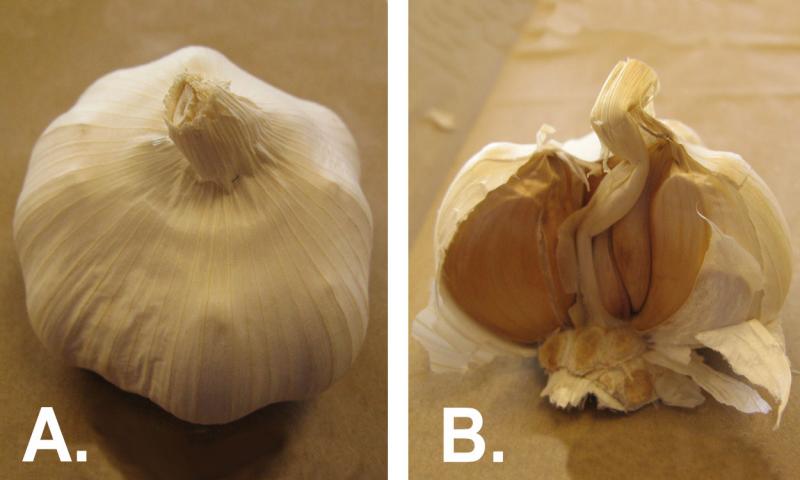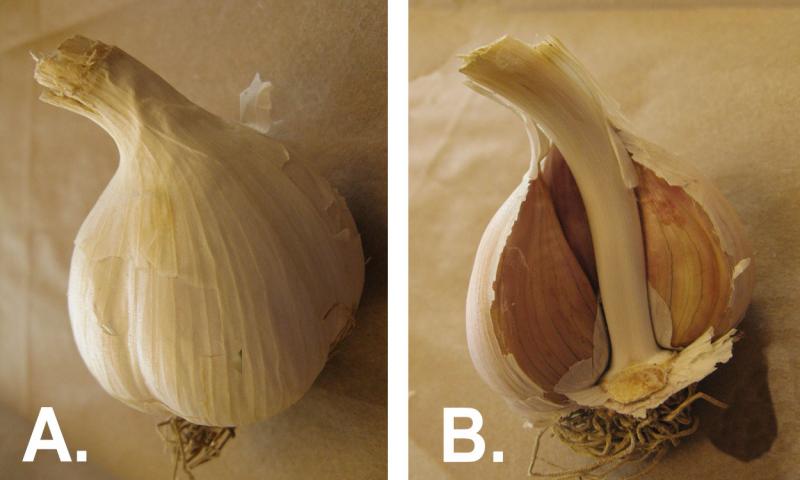Written by Rhoda Burrows, former Professor & SDSU Extension Horticulture Specialist.
Fresh garlic from your garden is crisp and juicy with a bright flavor that is lost as the bulbs sit in long-term storage. Chefs will delight in having a fresh supply of this delicious member of the lily family. The flowering stems, or scapes, of hardneck types can also be used for a milder addition to dishes during the summer. Removing the scapes as they appear will also help the plant put most of its energy into the bulb rather than flowers.
Garlic is planted late in the fall, before the soil freezes. The roots will develop and the cold treatment stimulates it to split into individual cloves.
Before planting, you need to choose the proper type of garlic for your area. Do not use garlic purchased at the grocery store. It may be harboring bacterial, viral or fungal diseases that do not affect cooking quality, but will prevent it from growing and developing properly. Garlic for planting can be purchased from your local nursery or online from a company that specializes in certified disease-free stock. Garlic can be found in the following types.
Garlic Types

Softneck
This is the type most commonly found in grocery stores. It is the type of garlic grown in areas with warmer winters, but some varieties are hardy for South Dakota.
The center stem is soft and dries to a papery consistency. They usually do not produce flower stalks (scapes), but they may under some growing conditions.
Softneck varieties store well and are the kind used for garlic braids. They are good for long-term storage and have a milder flavor. They have up to 15-18 cloves per head and can be difficult to peel.

Hardneck
The center stem in these garlics is very hard and often needs strong pruners to trim back at harvest, giving them their name. They grow best in colder climates with a cool, damp spring.
Each head will produce four to five large, easy to peel cloves. The flavor differs by variety, but it is generally stronger than softneck garlics.
Some varieties have a great deal of heat and are excellent for roasting, which moderates the heat and adds a nutty flavor.
Planting Garlic
Wait until the soil has cooled before planting garlic; 50 degrees Fahrenheit at four-inches deep is ideal. If planted too early, the bulb may be more susceptible to winter damage, and if planted too late, the roots will not have time to establish. Two or three weeks after the first frost, or mid-October, depending on the year, should be about right.
To reduce potential disease problems, do not plant where onions or garlic have been grown in the past three years. Before planting garlic, prepare the soil well. Cultivate at least eight inches deep, working compost into the soil. Garlic does not tolerate hard-packed soils and will not produce large bulbs in those conditions.
Garlic can be planted in a block configuration. This saves space, allowing more to be grown in a small area. Separate the bulb into individual cloves. The larger cloves will result in stronger plants. Leave the peel and basal plate (old root area) intact. Peeling the cloves will expose them to fungal diseases and rot if the soil gets too wet, so leave as much skin as practical.
Space the cloves four-to-five inches apart in all directions and four-to-six inches deep. This depth will help them overwinter without hard freezing. Firm the soil so there are no air spaces and water thoroughly. Do not add fertilizer at this point. When the soil has frozen, put six-to-eight inches of straw or leaf mulch on top. This will prevent frost heave if there are freeze/thaw cycles.
Garlic is easy to grow, takes very little space and is a true treat. Grow some yourself this fall to enjoy next year.


